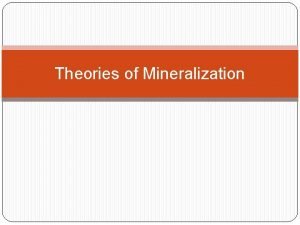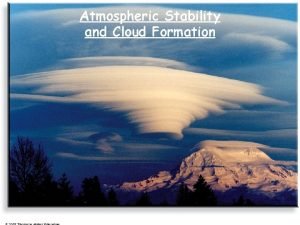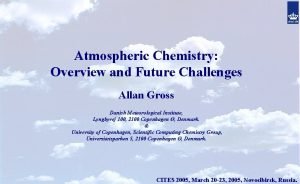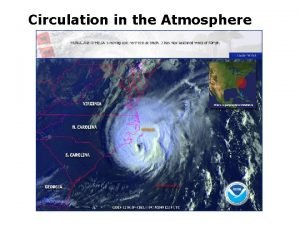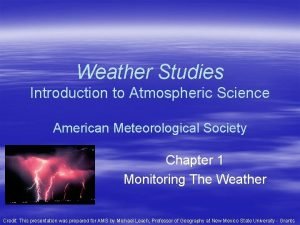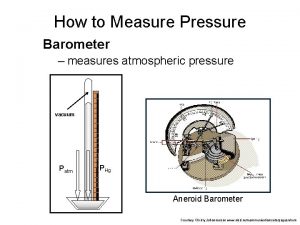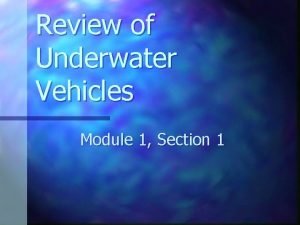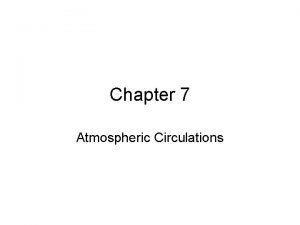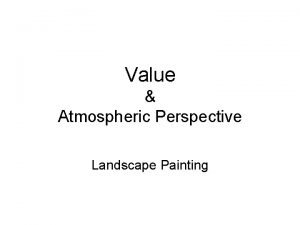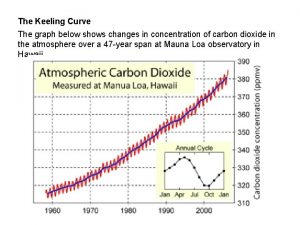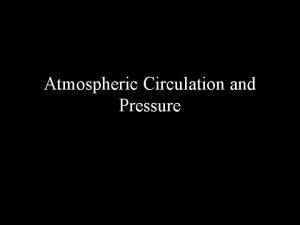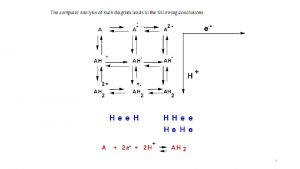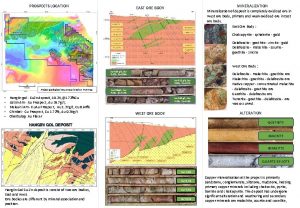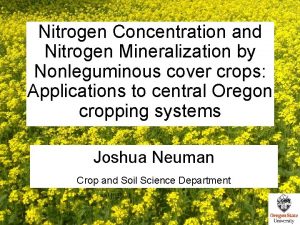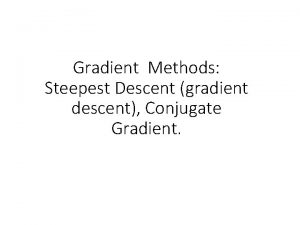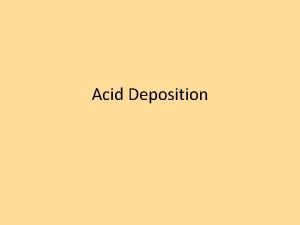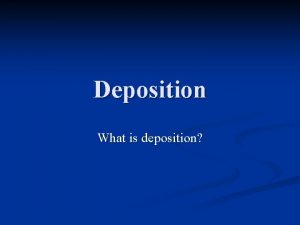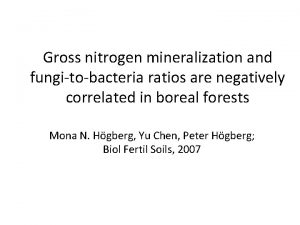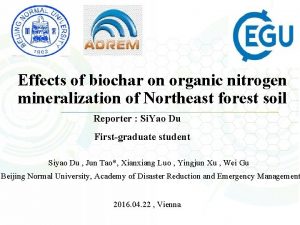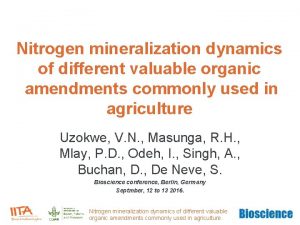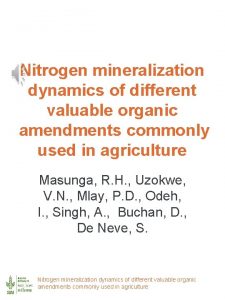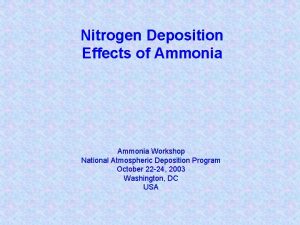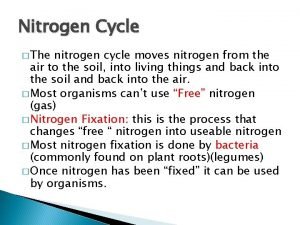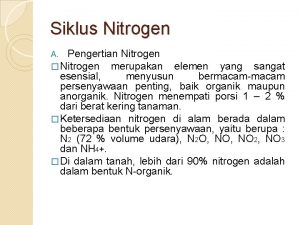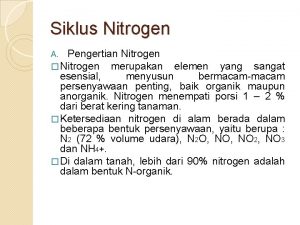Nitrogen Mineralization Across an Atmospheric Nitrogen Deposition Gradient
















- Slides: 16

Nitrogen Mineralization Across an Atmospheric Nitrogen Deposition Gradient in Southern California Deserts Leela E. Rao 1, David R. Parker 1, Andrzej Bytnerowicz 2, and Edith B. Allen 3 1 Dept. of Environmental Sciences, University of California, Riverside 2 U. S. Forest Service Fire Laboratory, Riverside, CA 3 Dept. of Botany and Plant Sciences and Center for Conservation Biology, University of California, Riverside, CA

Background • N deposition has been shown to affect natural areas in the greater Los Angeles area – Altered soil processes (Fenn et al. 1996) – Mycorrhizae (Egerton-Warburton and Allen 2000) – Enhanced invasive grass growth (Allen et al. 1998) • Primary source of anthropogenic nitrogen in the region are cars and trucks producing NOx. Atmospheric NH 3 is produced from catalytic converters and agriculture. • Joshua Tree National Park is located 140 miles east of Los Angeles and is under a gradient of N deposition.

July 2005 HNO 3 (mg/m 3) 2. 7 - 3. 7 3. 8 - 5. 0 5. 1 - 6. 0 6. 1 - 7. 1 7. 2 - 10. 1 10. 2 - 15. 3 July 2005 NH 3 (mg/m 3) 3. 9 - 5. 0 5. 1 - 6. 0 6. 1 - 7. 0 7. 1 - 10. 3 10. 4 - 13. 5 13. 6 - 19. 9

March 2005 HNO 3 (mg/m 3) 0 - 0. 75 0. 76 - 1. 5 1. 6 - 2. 0 2. 1 - 2. 5 2. 6 - 3. 25 3. 26 - 5. 75 March 2005 NH 3 (mg/m 3) 0 - 0. 99 1. 0 - 1. 45 1. 46 - 1. 75 1. 76 - 2. 25 2. 26 - 3. 0 3. 1 - 6. 4

Nitrogen Mineralization • N mineralization may be an indicator of N deposition and used to define critical loads for deposition effects on soils • Mineralization is known to be affected by: – Environmental conditions (soil temperature, moisture) – Litter quality (carbon and nitrogen content) – Soil texture (water holding capacity, OM sorption) • N deposition has been found to increase nitrification rates and increase nitrogen content of litter

Objectives 1. Examine potential nitrogen mineralization across a nitrogen gradient to determine effects of increased nitrogen inputs on nitrogen dynamics 2. Determine the extent to which nitrogen supply through mineralization is correlated with exotic annual grass cover 3. Examine the extent to which other soil factors may be influencing nitrogen dynamics and exotic grass cover in this region Hypothesis Because microbial processes in arid systems are often limited in both carbon and nitrogen (Schaeffer et al. 2003) we hypothesize that nitrogen deposition should increase mineralization by increasing both total production of herbaceous annuals (Allen et al. 2007) and the nitrogen content of the annuals (Sirulnik et al. 2007).

Methods • Soils were collected in July from sixteen sites in and around Joshua Tree Park and brought to the laboratory for a 14 week mineralization incubation experiment – Soils were brought to 60% WFPS and incubated at 25°C – Three replicate samples were extracted for inorganic N at regular intervals • Percent cover of native and exotic vegetation was recorded at each site • Percent rock cover, bulk density, p. H, total C, organic C, and total N of the soils was also determined for each site

Results: Mineralization Incubation

Results: Soil Properties Measured soil properties (bulk density, p. H, % sand-silt-clay, percent cover of rocks) were correlated. High BD, High p. H Principal components analysis performed on correlations to create two, uncorrelated soil characteristic variables. Low BD, Low p. H Very sandy SHBD DP SLBD DP: desert pavement, SHBD: sandy with high bulk density, SLBD: sandy with low bulk density More silts/clays

N-Mineralization & Soil Properties • No effect of soil grouping on mineralization rate observed • Total amount of N mineralized was significantly lower in the desert pavement sites compared to the sandy, low bulk density sites (ANOVA P = 0. 014) DP: desert pavement, SHBD: sandy with high bulk density, SLBD: sandy with low bulk density

C: N Ratio • No relationship between C: N and soil groupings (P = 0. 14) • No effect of C: N on mineralization rate (R 2 = 0. 13) • Total N mineralized increased as C: N decreased (R 2= 0. 43; P = 0. 006)

Annual Vegetation • No relationship between native or exotic cover and nitrogen supply (R 2 = 0. 18; P = 0. 105) or the C: N (R 2 = 0. 18; P = 0. 102) • Major controlling factor on exotic cover in this region appears to be presence of desert pavement (P=0. 037) DP: desert pavement, SHBD: sandy with high bulk density, SLBD: sandy with low bulk density

N-Deposition • Strong correlation between July atmospheric HNO 3 and extractable soil N (R 2=0. 75; P<0. 0001) but no grouping of soil along HNO 3 gradient (P = 0. 107) • Expected soil N from deposition calculated using monthly deposition velocities, seasonal averages of HNO 3 and NH 3, and soil bulk densities • Predicted soil N and initial soil N were also correlated (R 2=0. 74; P < 0. 0001) DP: desert pavement, SHBD: sandy with high bulk density, SLBD: sandy with low bulk density

N-Mineralization and Deposition • Inorganic nitrogen from soils collected in July are directly correlated with the Ndeposition gradient. • Amount of nitrogen mineralized is also directly correlated with the initial amount of extractable nitrogen (R 2 = 0. 76; P<0. 0001)

Conclusions • Nitrogen deposition is affecting the amount of nitrogen mineralized but not the rate of the mineralization in this region. • Mineralization is increased by improved SOM quality (decreased C: N) and is decreased in desert pavement areas. • Although nitrogen supply is increased in high deposition areas, exotic species cover is not affected by deposition. • Exotic species seem to be excluded from desert pavement areas, which may become a refuge for native species if invasion increases.

Acknowledgements Field Assistance: Robert Steers, Robin Marushia, Chris True, Greg Miller Lab Assistance: Catrina Paez Funding Sources: U. C. IPM program, Joshua Tree National Park, and NSF grants
 Theories of mineralization in dentistry
Theories of mineralization in dentistry Atmospheric vortex engine
Atmospheric vortex engine Conditionally unstable atmosphere
Conditionally unstable atmosphere Atmospheric reaction
Atmospheric reaction Atmospheric convection
Atmospheric convection Penn state atmospheric science
Penn state atmospheric science Atmospheric circulation
Atmospheric circulation Atmospheric physics lecture notes
Atmospheric physics lecture notes Weather studies introduction to atmospheric science
Weather studies introduction to atmospheric science Mercury barometer
Mercury barometer Atmospheric diving suit
Atmospheric diving suit Single cell model of atmospheric circulation
Single cell model of atmospheric circulation Aerial perspective landscape painting
Aerial perspective landscape painting Hadley cells
Hadley cells Global warming
Global warming The graph below shows atmospheric carbon dioxide
The graph below shows atmospheric carbon dioxide Circulates air between 60-90 latitudes
Circulates air between 60-90 latitudes
